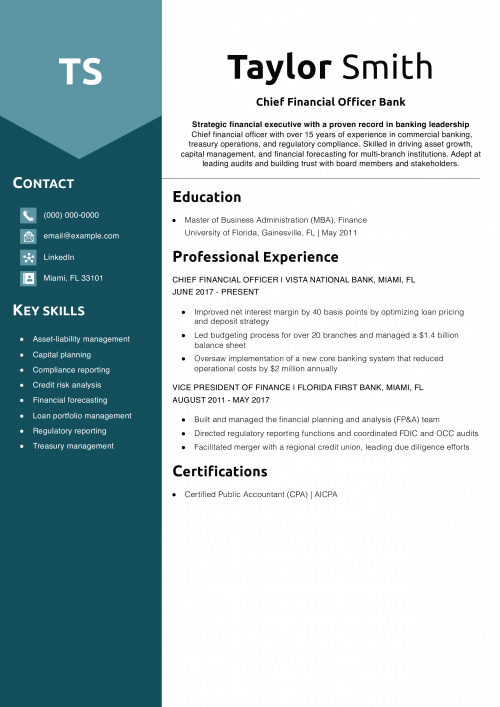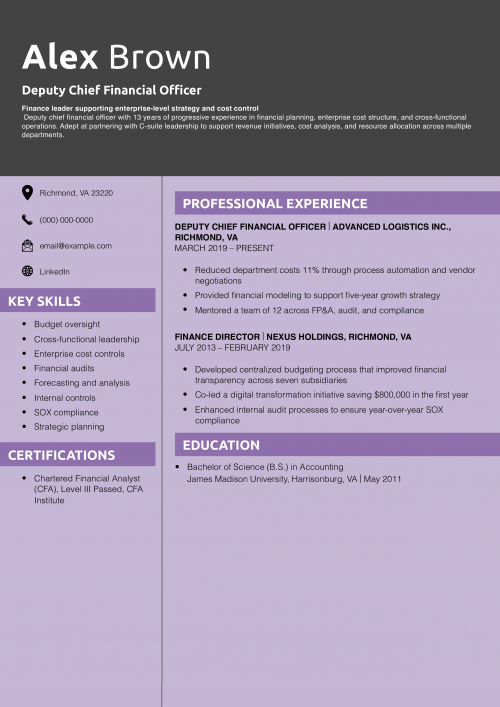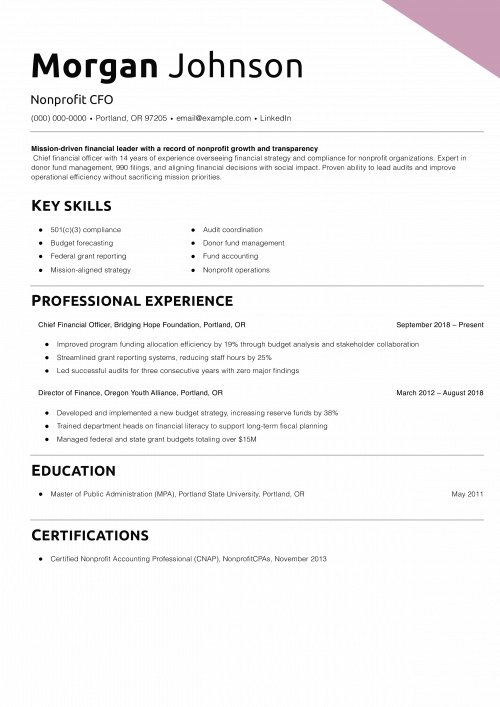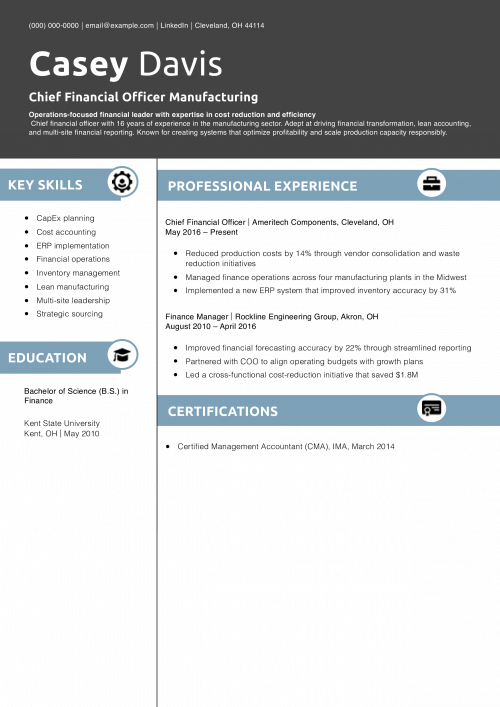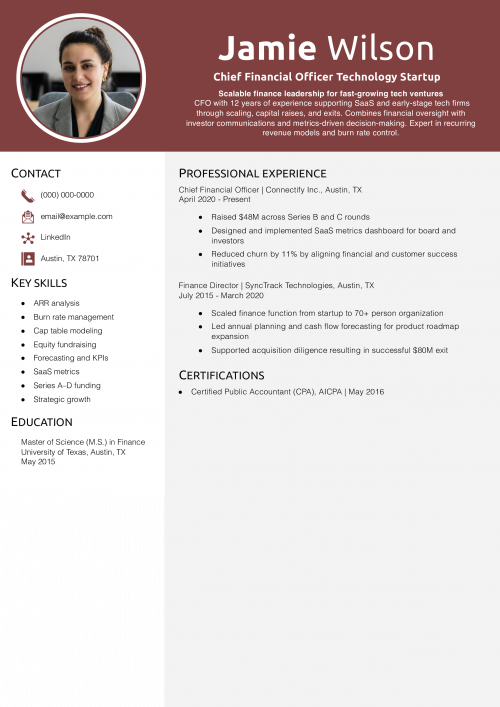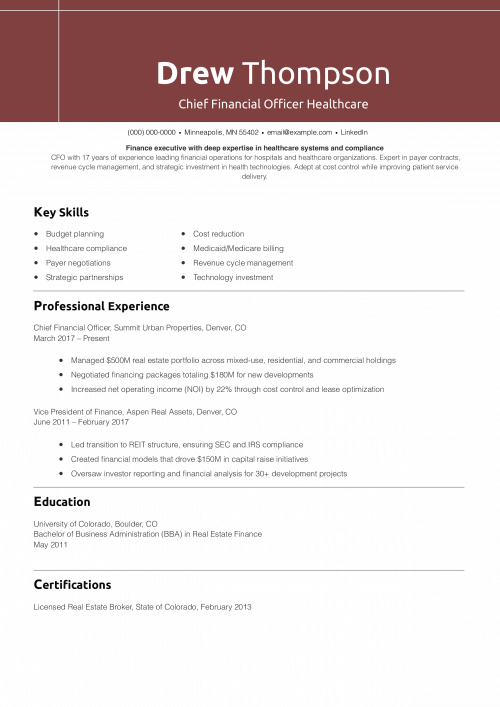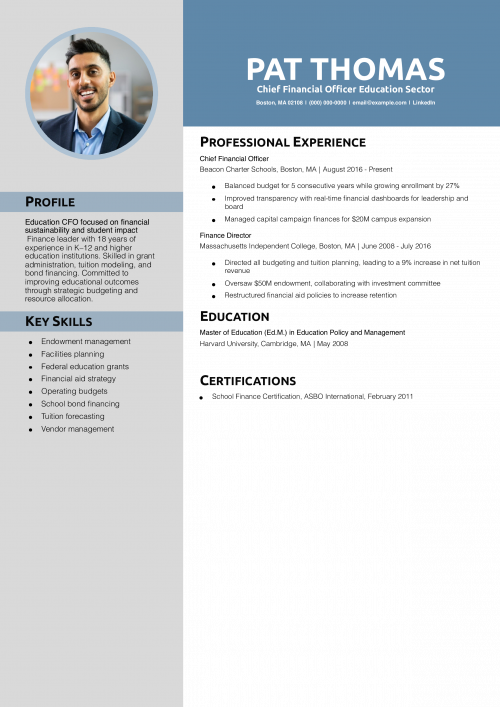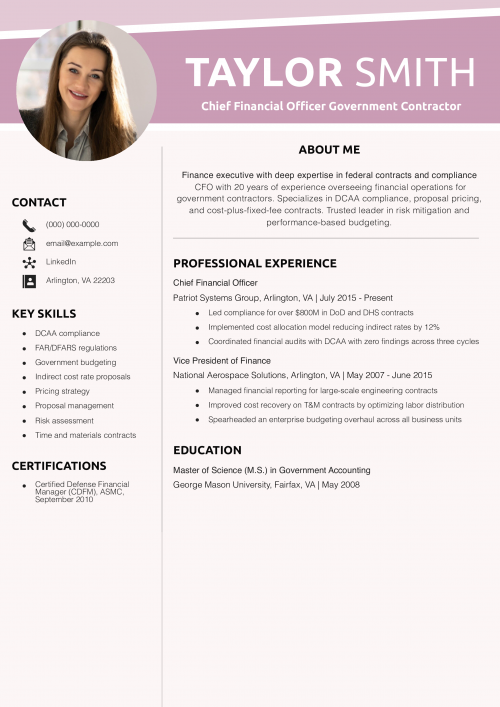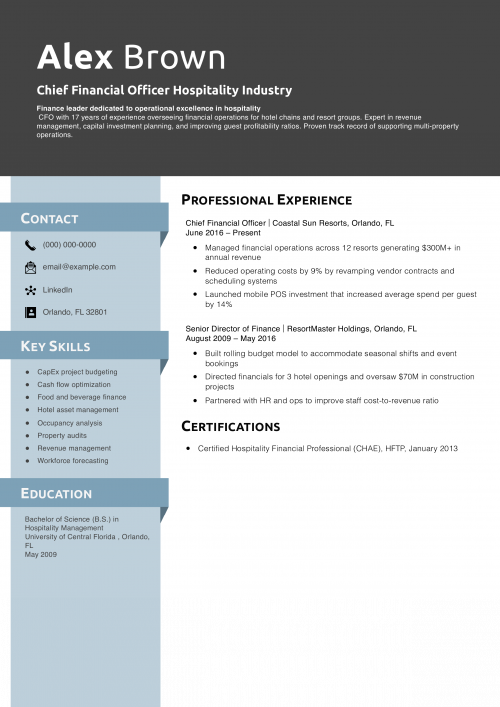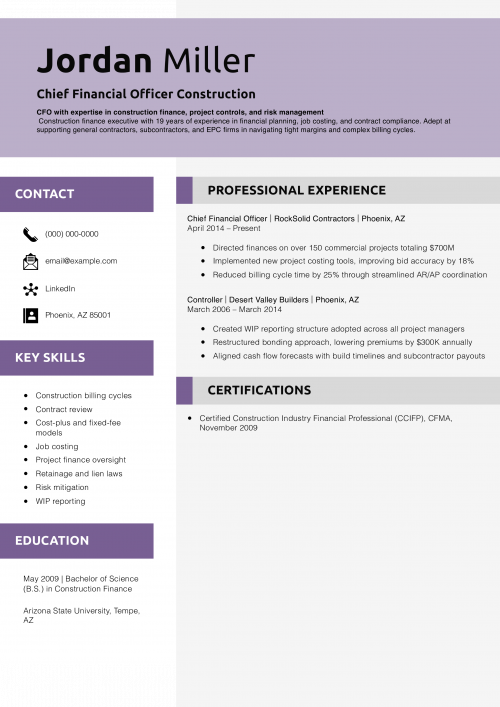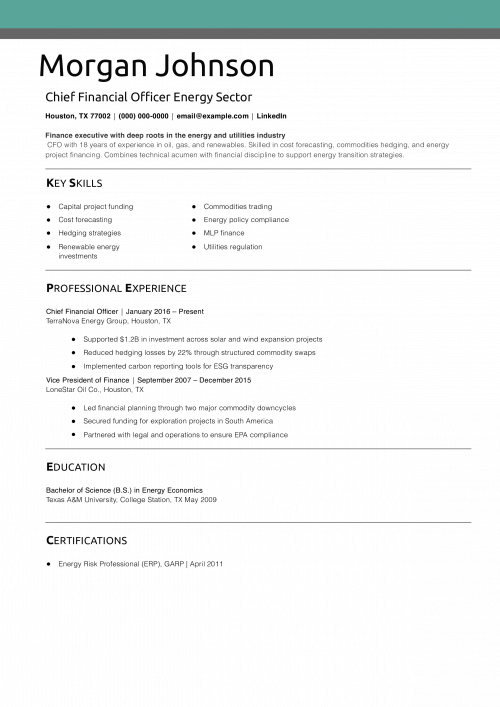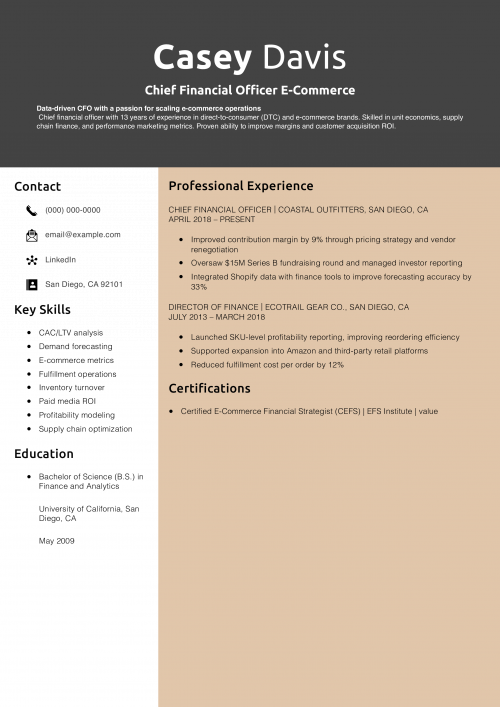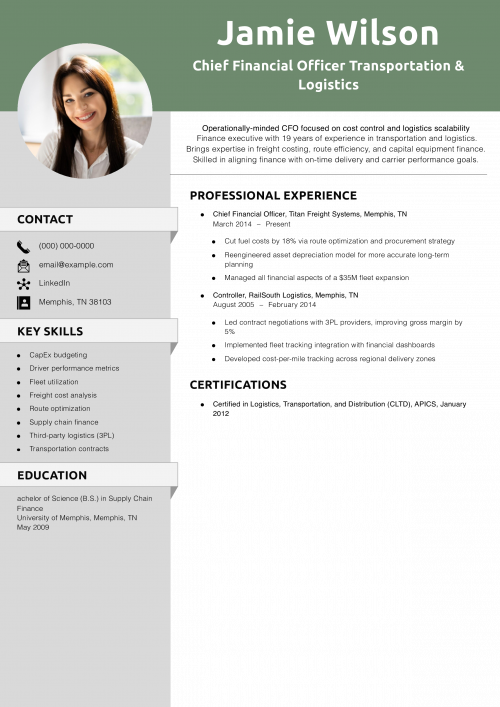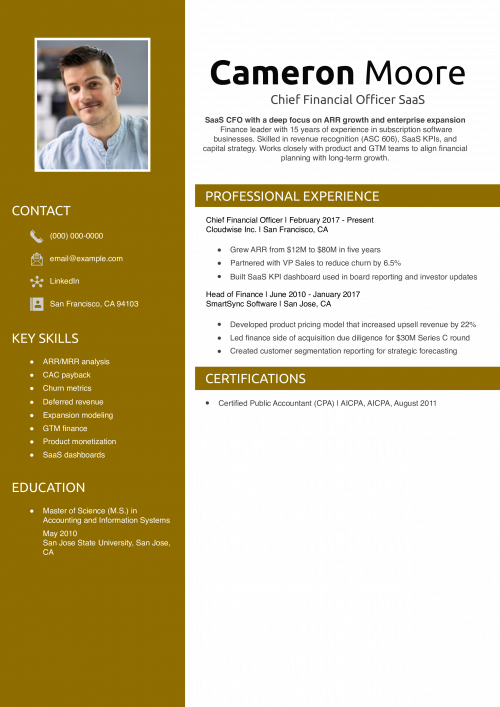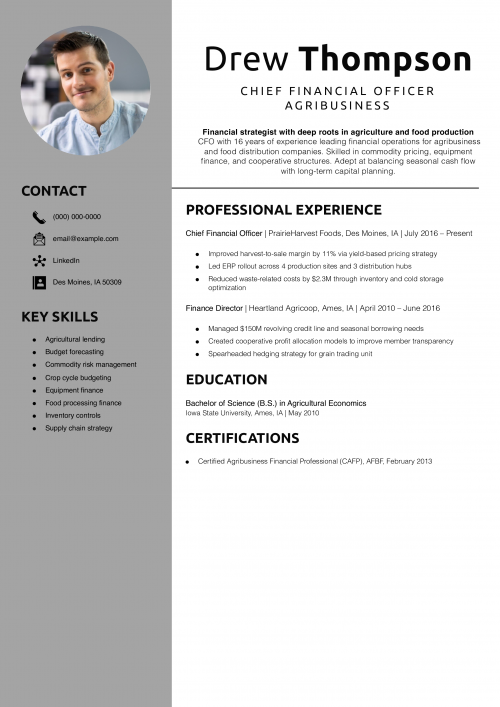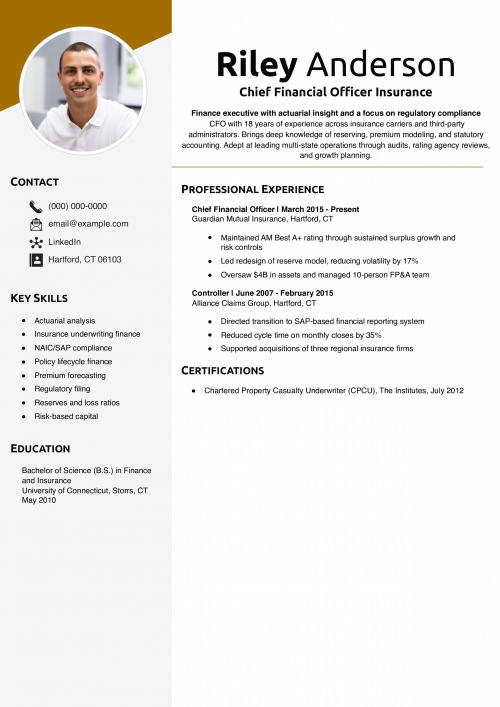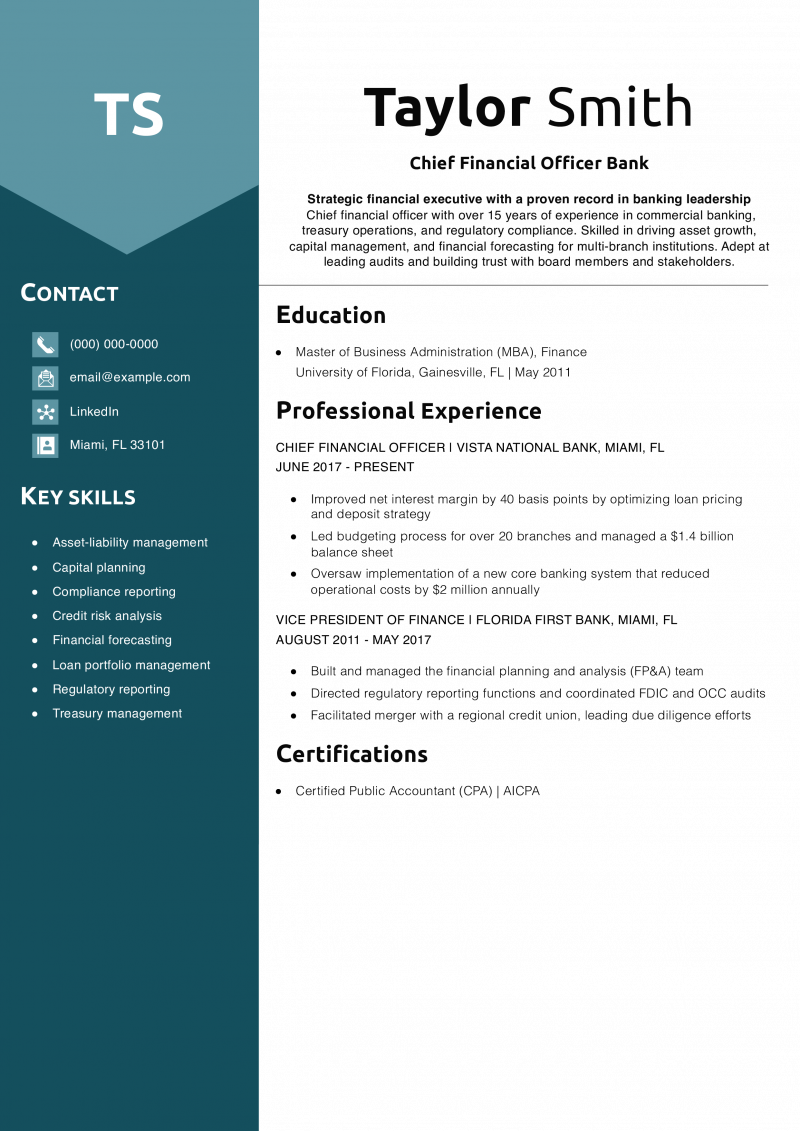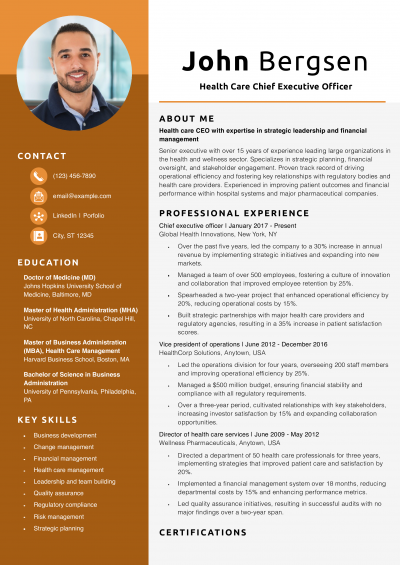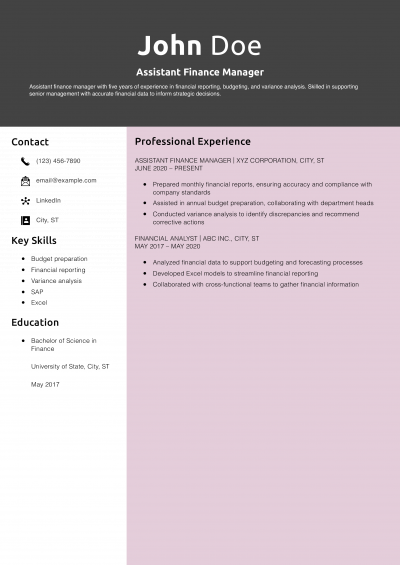A good CFO resume focuses on your main skills like strategic planning, cash flow management, or Sarbanes-Oxley (SOX) compliance. Give examples of your success as a CFO or in similar roles, and show your knowledge base by citing any advanced degree or certificate programs you’ve done. This guide provides expert tips to help you create a persuasive resume showing your best CFO qualifications.
Key takeaways:
- Brainstorm details about your work history on a separate document or blank sheet of paper. Then, identify the most relevant ones to feature in your experience section – this helps you focus your resume on the role of CFO.
- Spell out the positive impact of your work as a CFO. Describe how your efforts helped organizations define and achieve their financial goals.
- Follow the combination resume format to provide all required information while positioning yourself for CFO jobs that interest you.
Most Popular Chief Financial Officer (CFO) Resumes
Chief Financial Officer Bank Resume Example
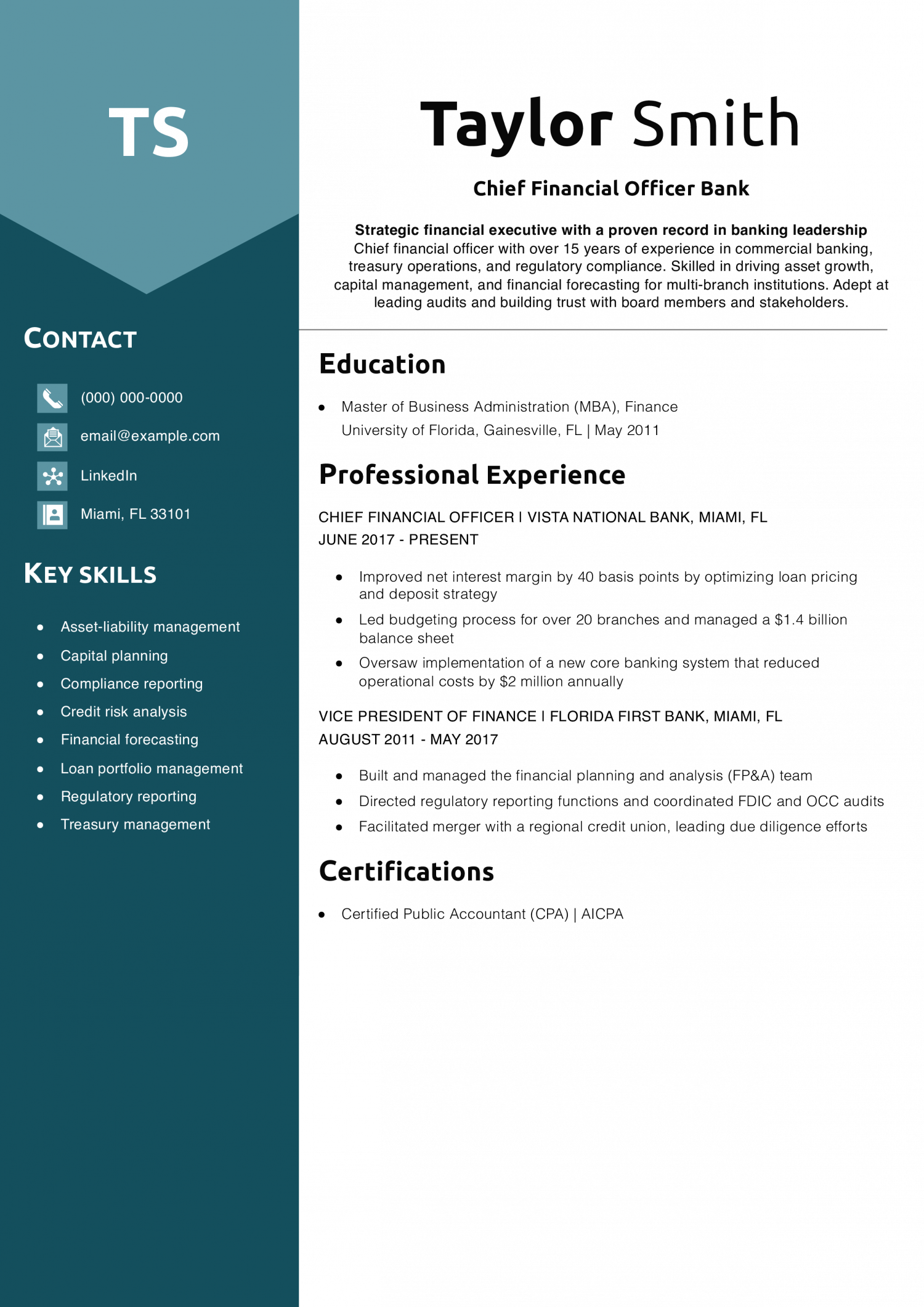
Why this chief financial officer bank resume example is strong:
Taylor’s resume emphasizes financial oversight in highly regulated environments. The experience section clearly ties strategic decisions to business growth and compliance. Board and regulatory alignment are crucial in banking, and this resume addresses both.
Deputy Chief Financial Officer Resume Example
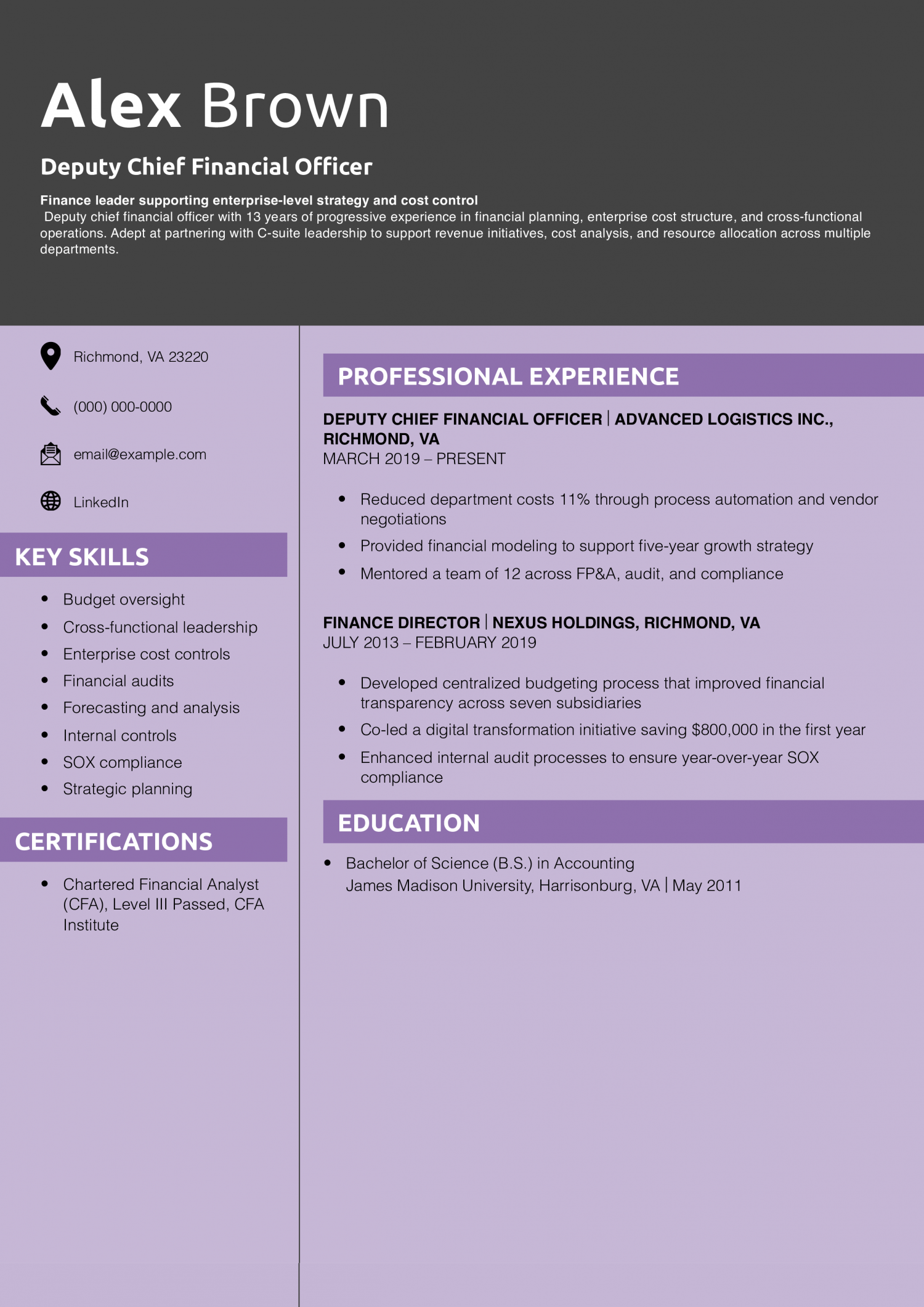
Why this deputy chief financial officer resume example is strong:
Alex clearly demonstrates readiness to step into a full CFO role. The resume highlights cost savings, team leadership, and long-term strategy contributions. Achievements are measurable, and each job focuses on impact, not just responsibilities.
Interim Chief Financial Officer Resume Example
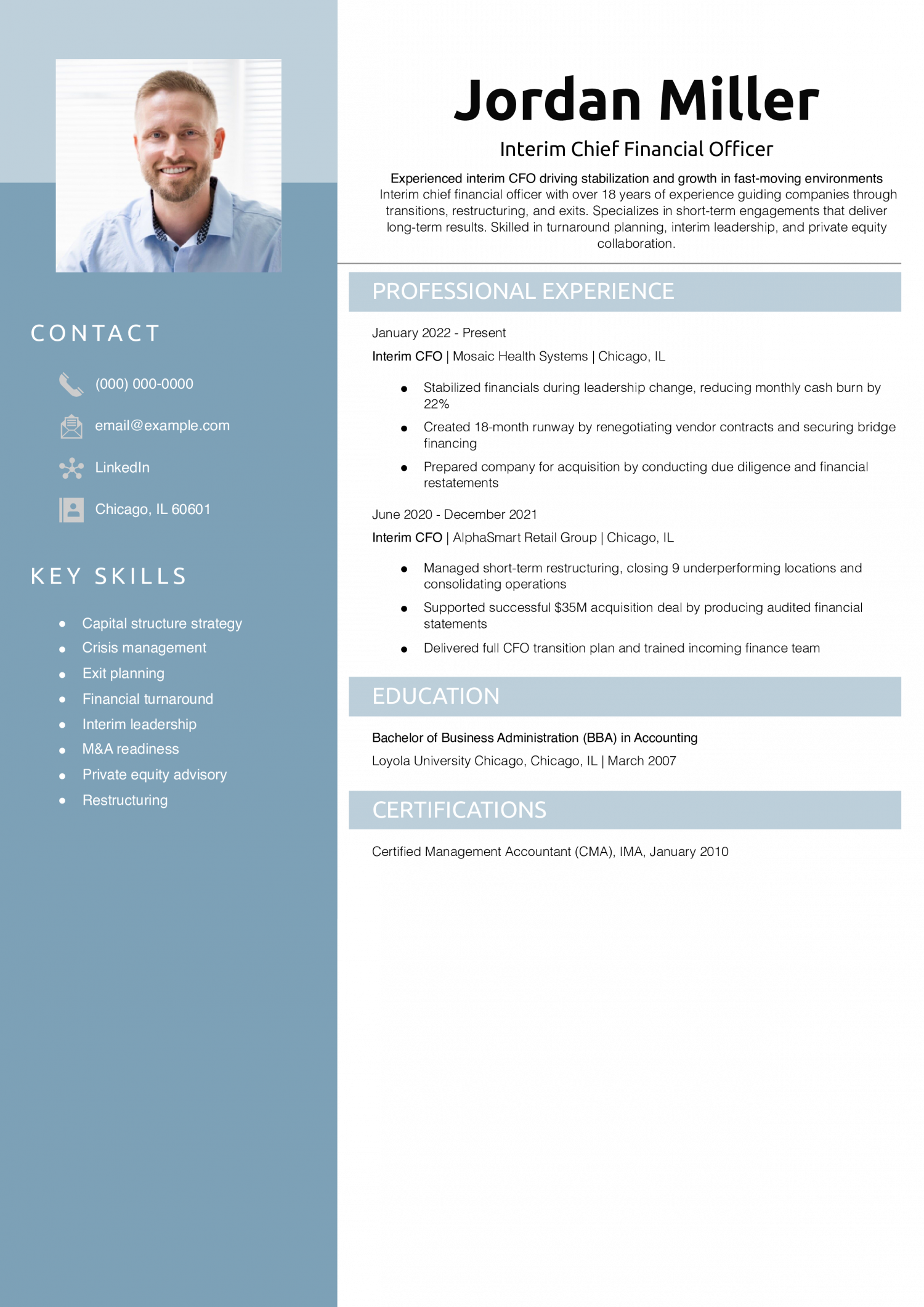
Why this interim chief financial officer resume example is strong:
Jordan’s resume targets interim engagements with a clear focus on turnaround success and transaction readiness. The experience speaks directly to what hiring managers need during times of change.
Nonprofit CFO Resume Example
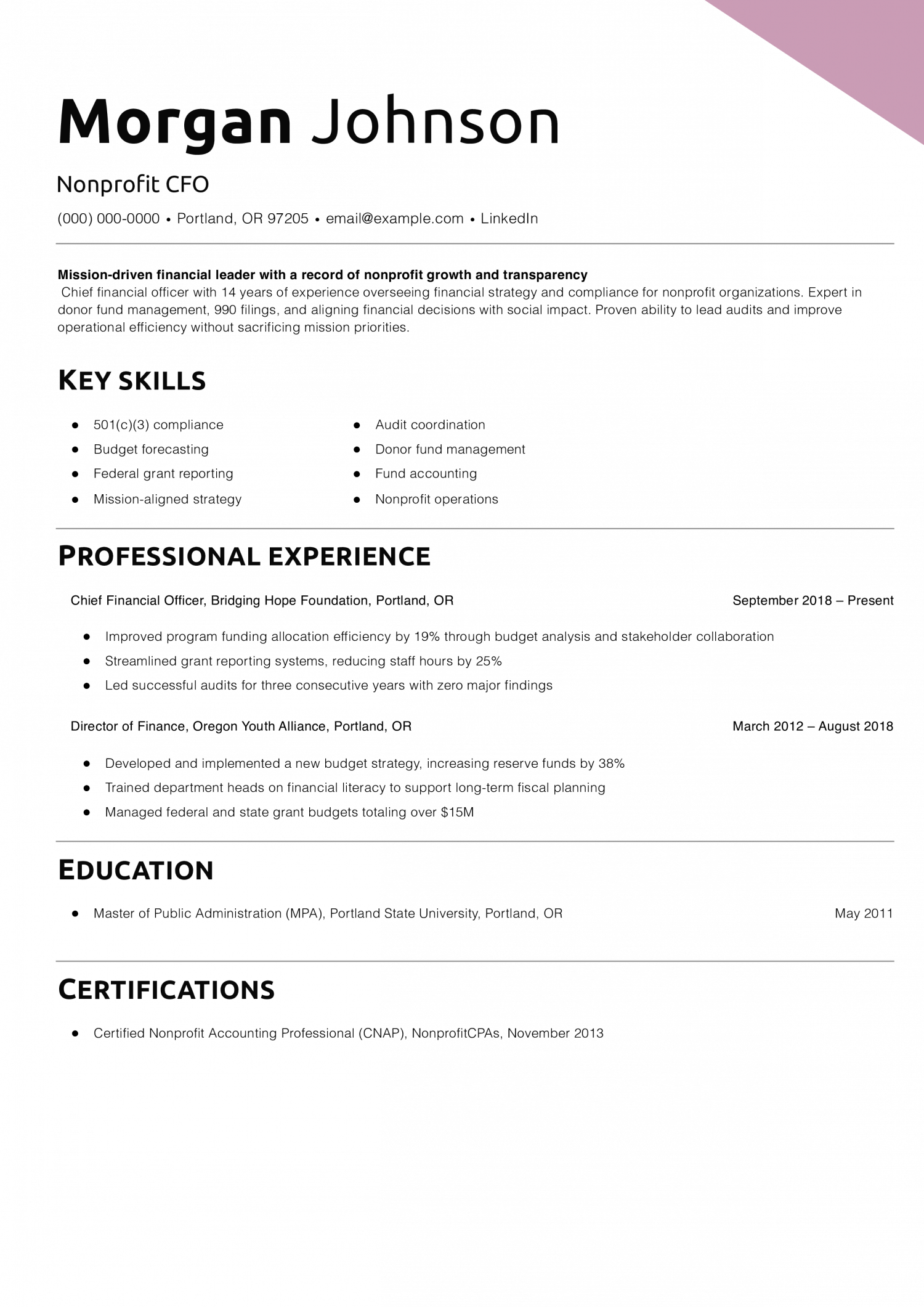
Why this nonprofit CFO resume example is strong:
Morgan’s resume focuses on mission-aligned outcomes and financial sustainability—both critical in nonprofit finance. Specific metrics help illustrate long-term strategic thinking and operational control.
Chief Financial Officer Manufacturing Resume Example
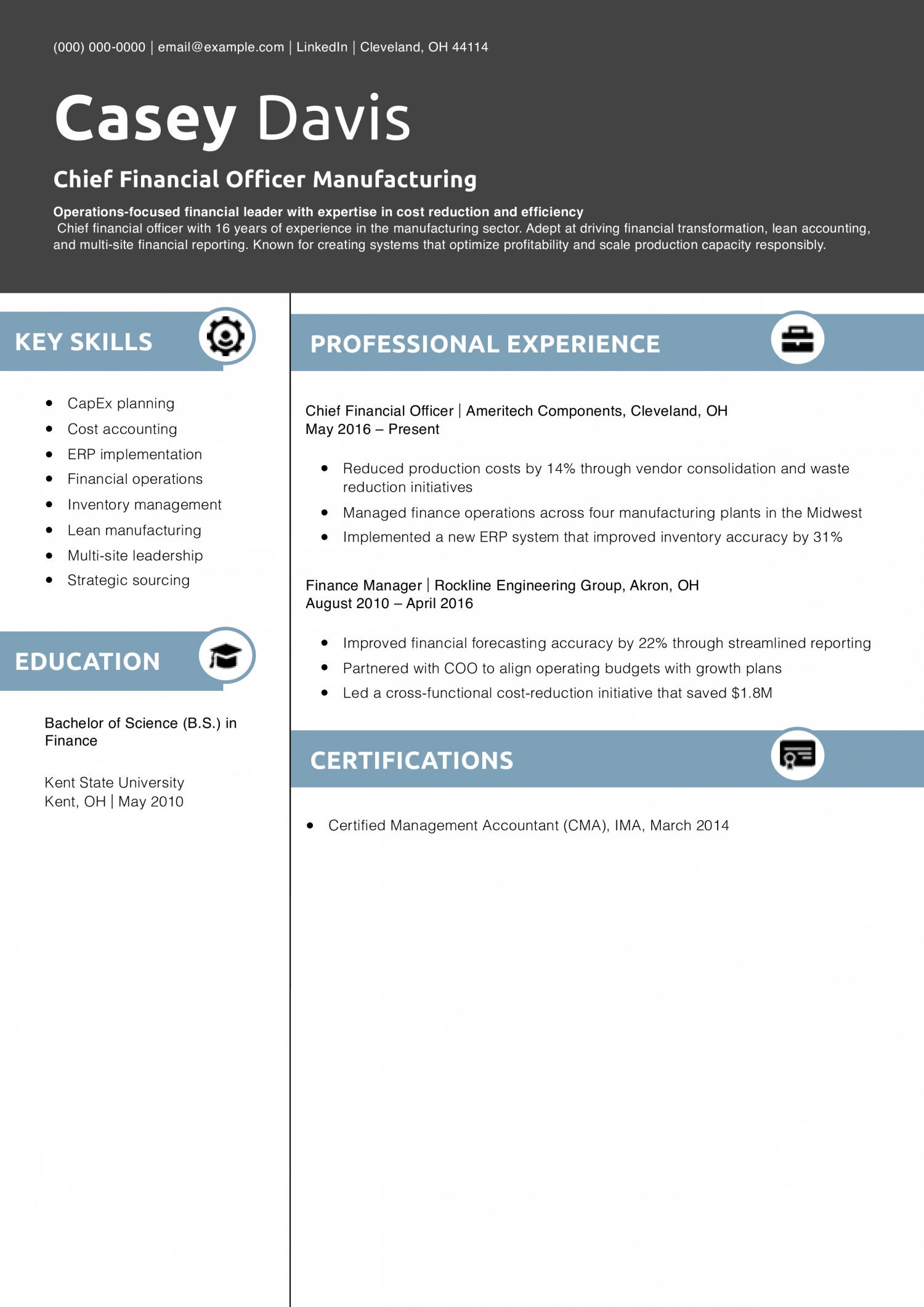
Why this chief financial officer manufacturing resume example is strong:
Casey’s experience in lean accounting and multi-plant operations aligns well with manufacturing CFO roles. The metrics reinforce success in cost savings and operational integration.
Chief Financial Officer Technology Startup Resume Example
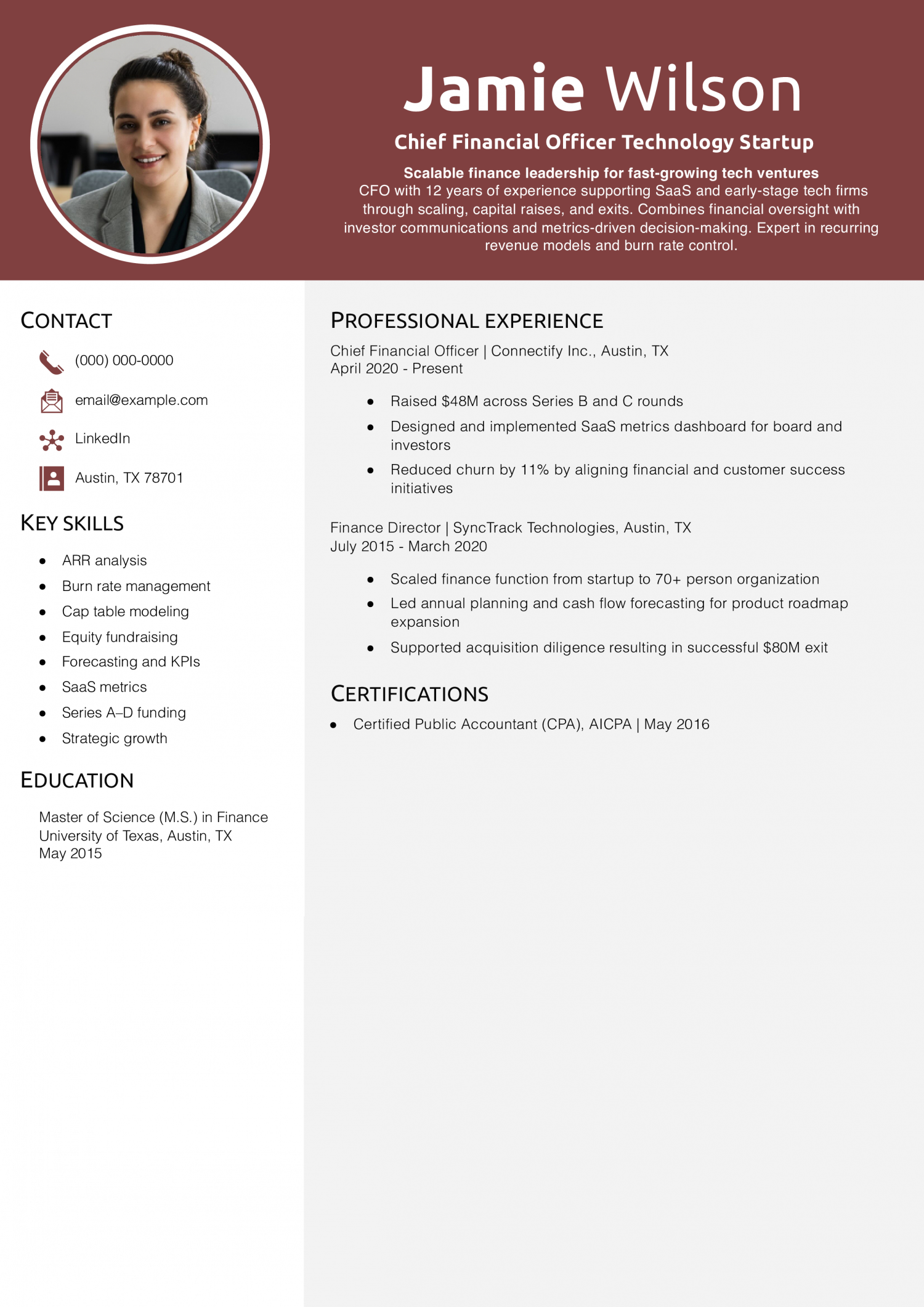
Why this CFO technology startup resume example is strong:
Jamie’s resume is full of investor-facing achievements and startup-relevant KPIs. The bullet points show traction, scale, and financial control—exactly what startups need in a CFO.
Chief Financial Officer Real Estate Resume Example
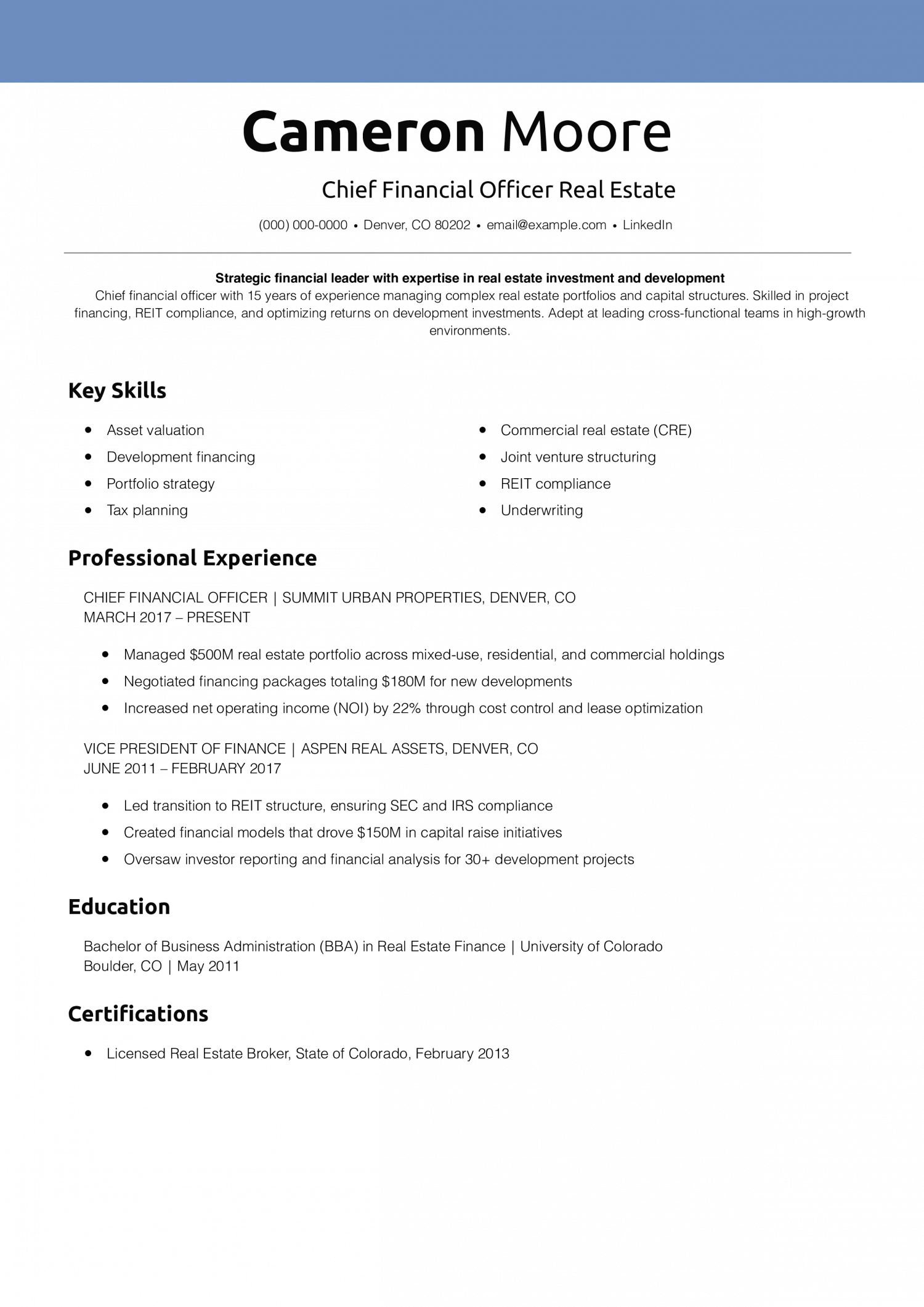
Why this CFO real estate resume example is strong:
Cameron’s resume reflects deep understanding of real estate operations and finance. The numbers back up impact, and the roles show steady growth in responsibility.
Chief Financial Officer Healthcare Resume Example
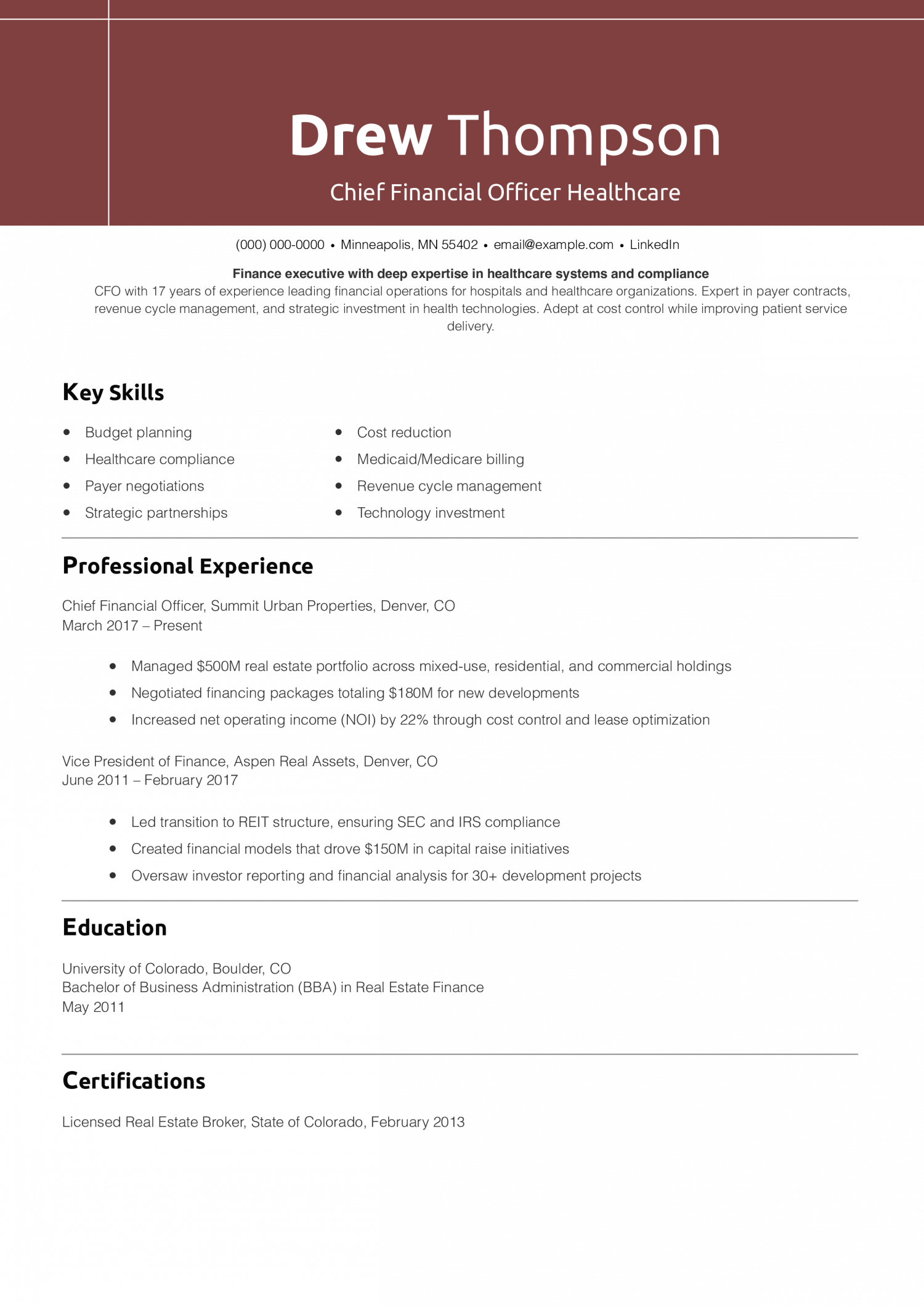
Why this healthcare CFO resume example is strong:
Drew demonstrates sector-specific knowledge, from payer management to EMR budgeting. It’s clear the resume is tailored to healthcare finance leadership.
Chief Financial Officer Retail Resume Example

Why this CFO retail resume example is strong:
Riley’s resume speaks the language of retail finance: shrink, margins, multi-unit strategy. The quantifiable results help underscore leadership and business outcomes.
Chief Financial Officer Education Sector Resume Example
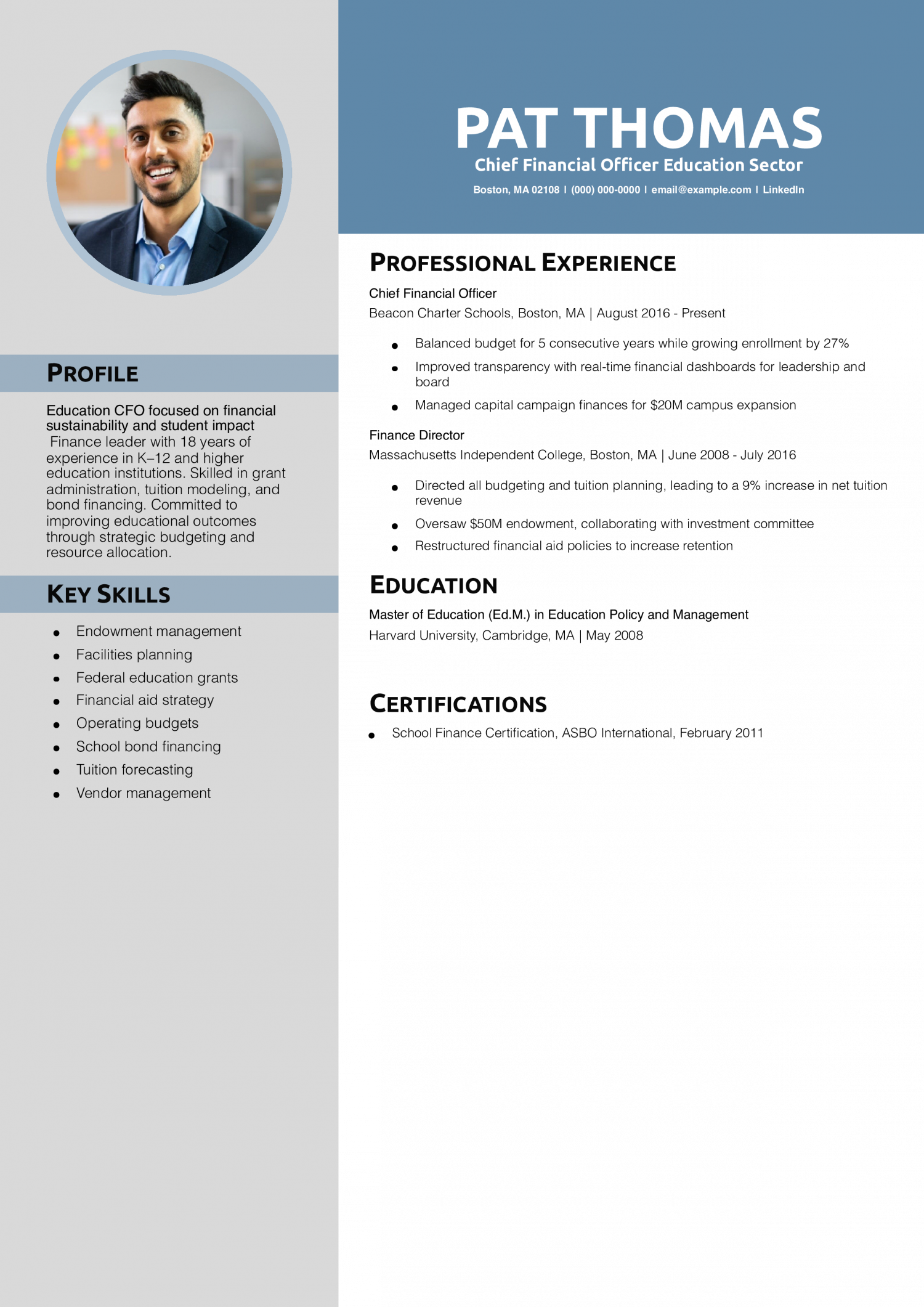
Why this CFO education resume example is strong:
Pat’s resume balances financial expertise with a strong connection to student outcomes and institutional missions. It’s targeted and data-backed.
Chief Financial Officer Government Contractor Resume Example
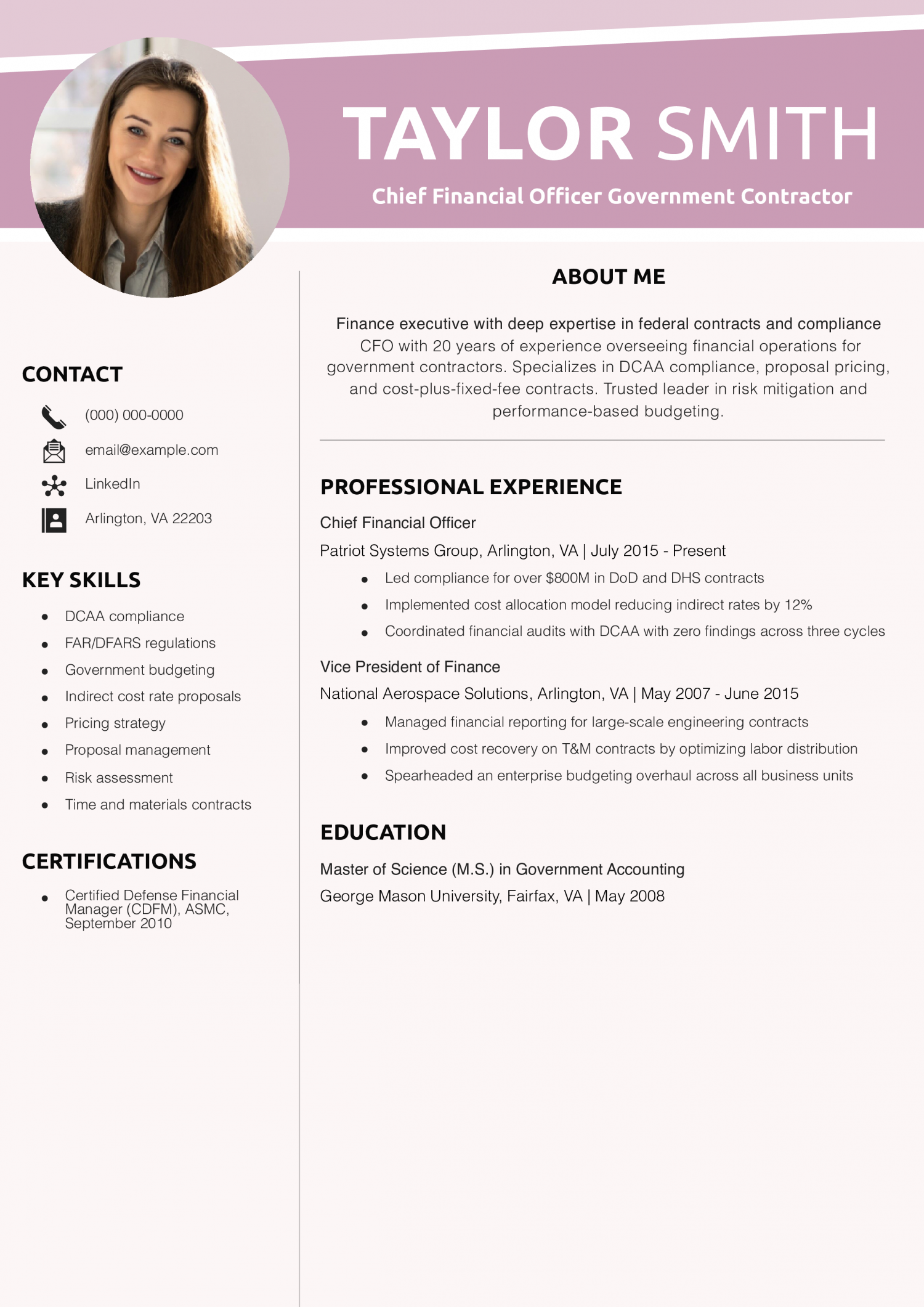
Why this CFO government contractor resume example is strong:
Taylor’s resume targets niche knowledge of federal regulations and government finance. Highlighting DCAA audits and pricing mastery is essential in this field.
Chief Financial Officer Hospitality Industry Resume Example
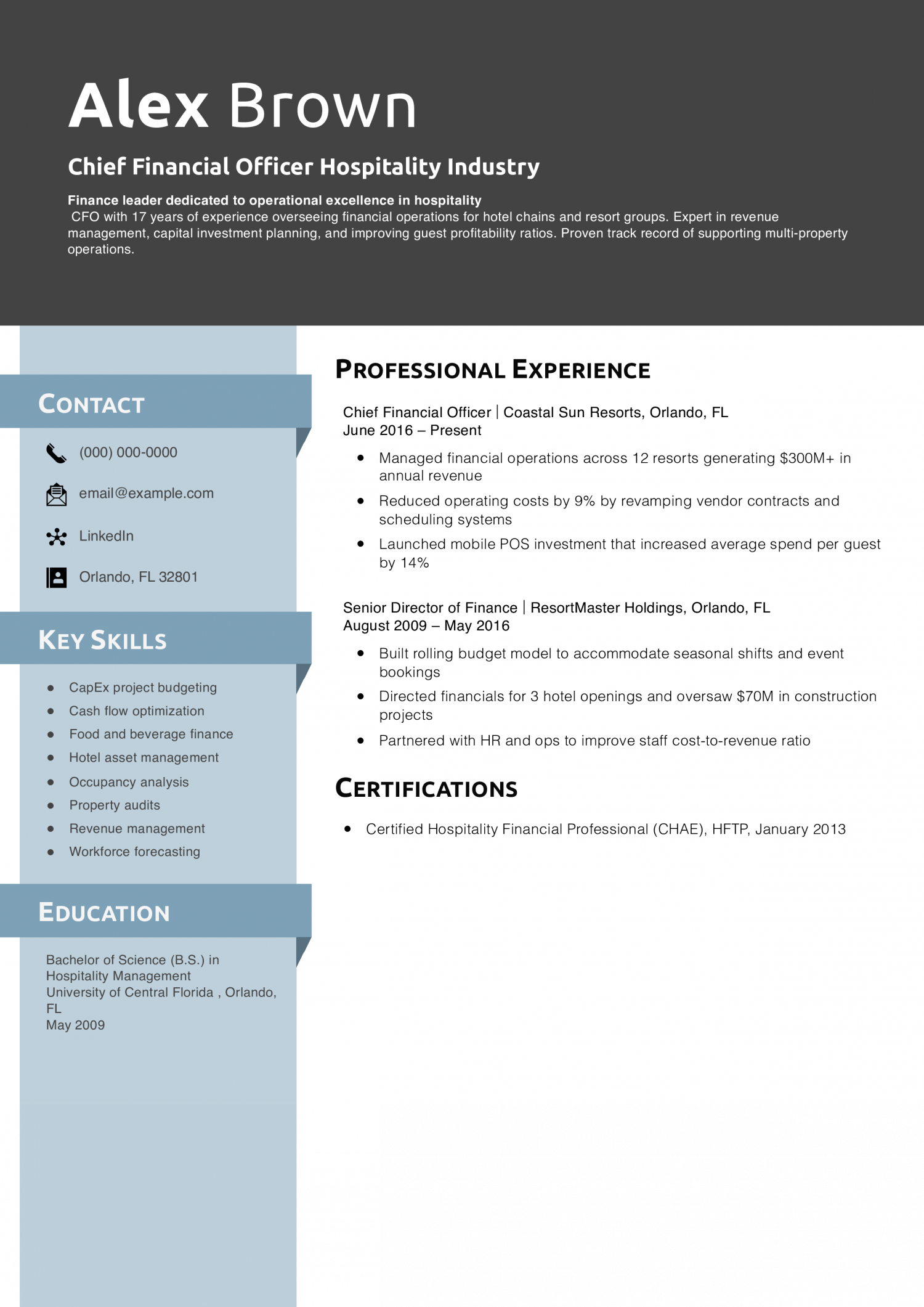
Why this hospitality CFO resume example is strong:
Alex shows a deep understanding of seasonal trends, operating metrics, and revenue levers specific to hospitality, making this resume a strong match for the industry.
Chief Financial Officer Construction Resume Example
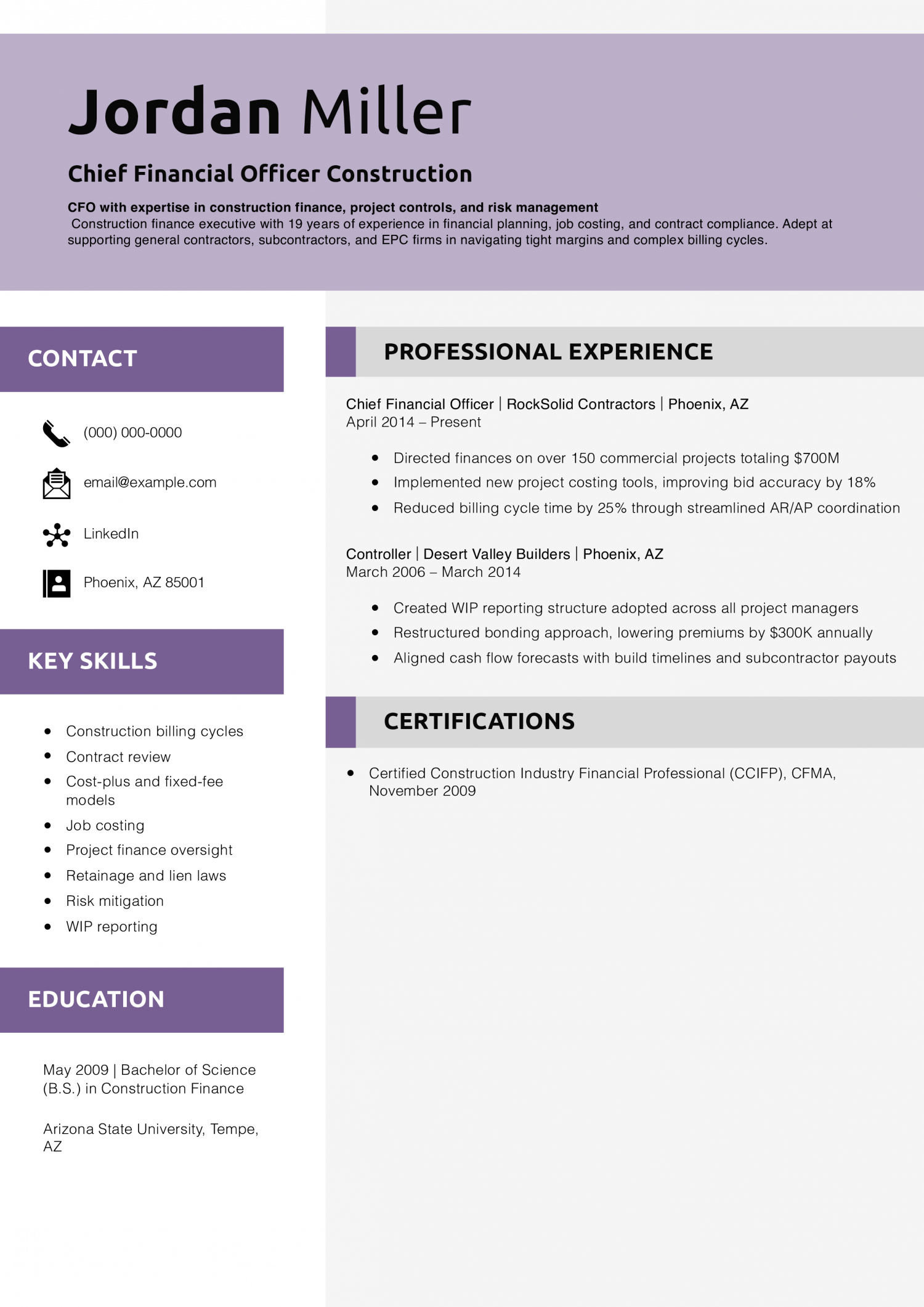
Why this CFO construction resume example is strong:
Jordan’s resume reflects expertise in project finance, bonding, and retainage—all essential to construction CFO roles. Timelines and quantifiable improvements add strength.
Chief Financial Officer Energy Sector Resume Example
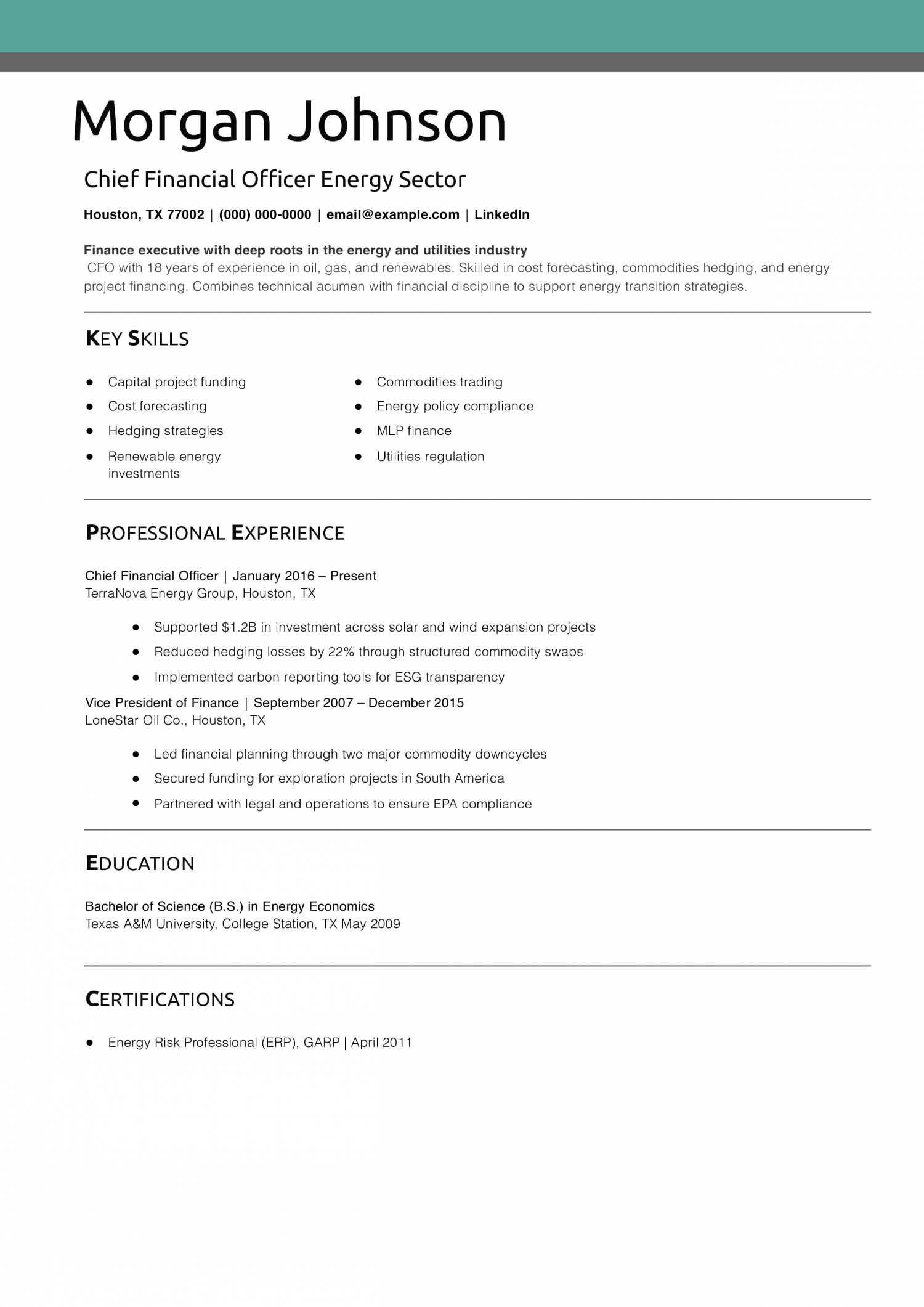
Why this CFO energy resume example is strong:
Morgan Johnson’s resume demonstrates deep sector knowledge by tying financial achievements directly to the unique challenges of the energy industry. From reducing hedging losses to managing $1.2B in renewable investments, the examples are both technical and strategic. This resume also highlights Morgan’s ability to navigate regulatory compliance and energy transition efforts, both of which are key priorities for modern energy companies.
Learn how to highlight your experience in a results-focused way
Chief Financial Officer E-Commerce Resume Example
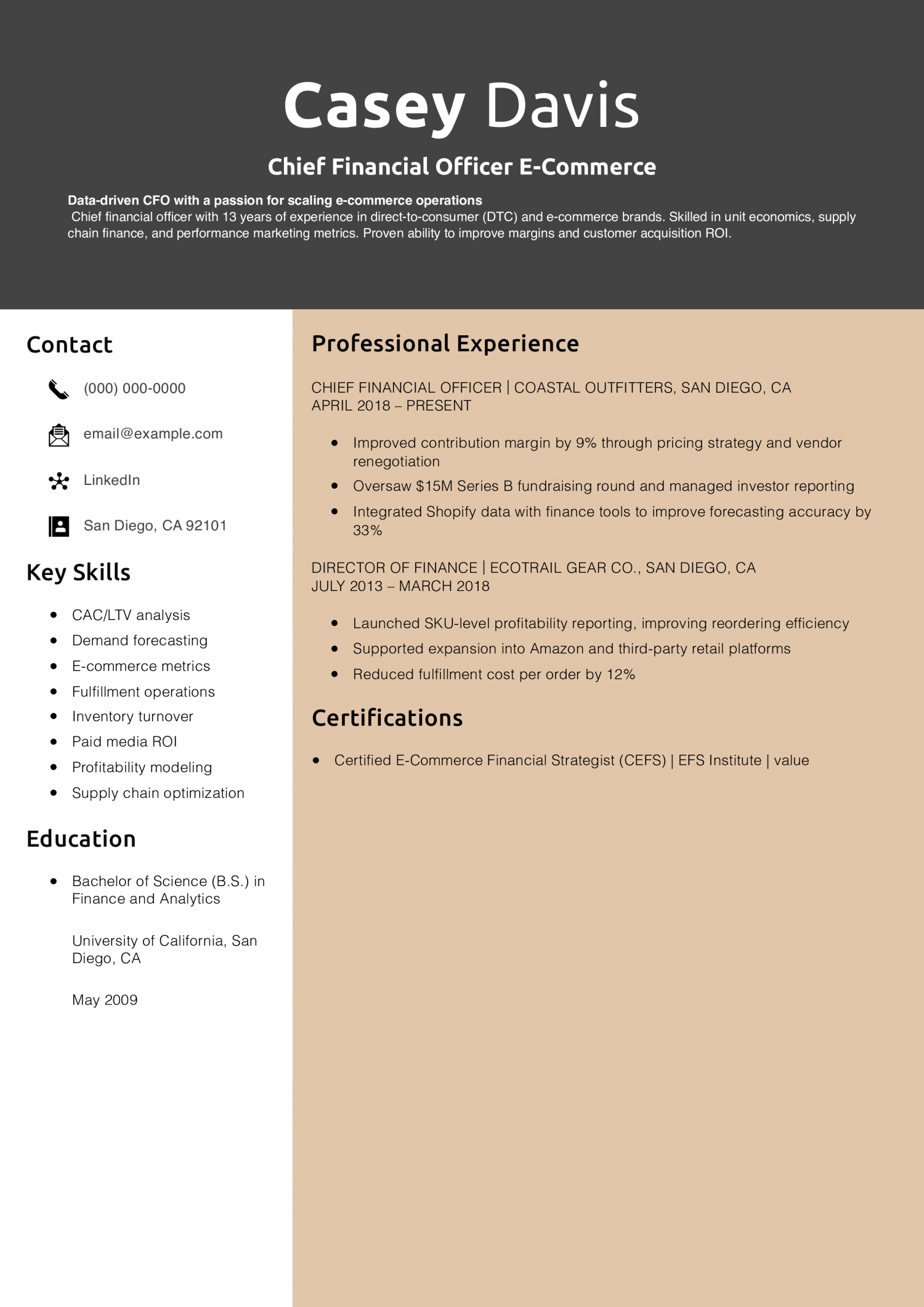
Why this CFO e-commerce resume example is strong:
Casey’s resume uses metrics like CAC and LTV to show e-commerce fluency. This data-focused approach fits modern DTC brands seeking ROI-focused leadership.
Chief Financial Officer Transportation & Logistics Resume Example
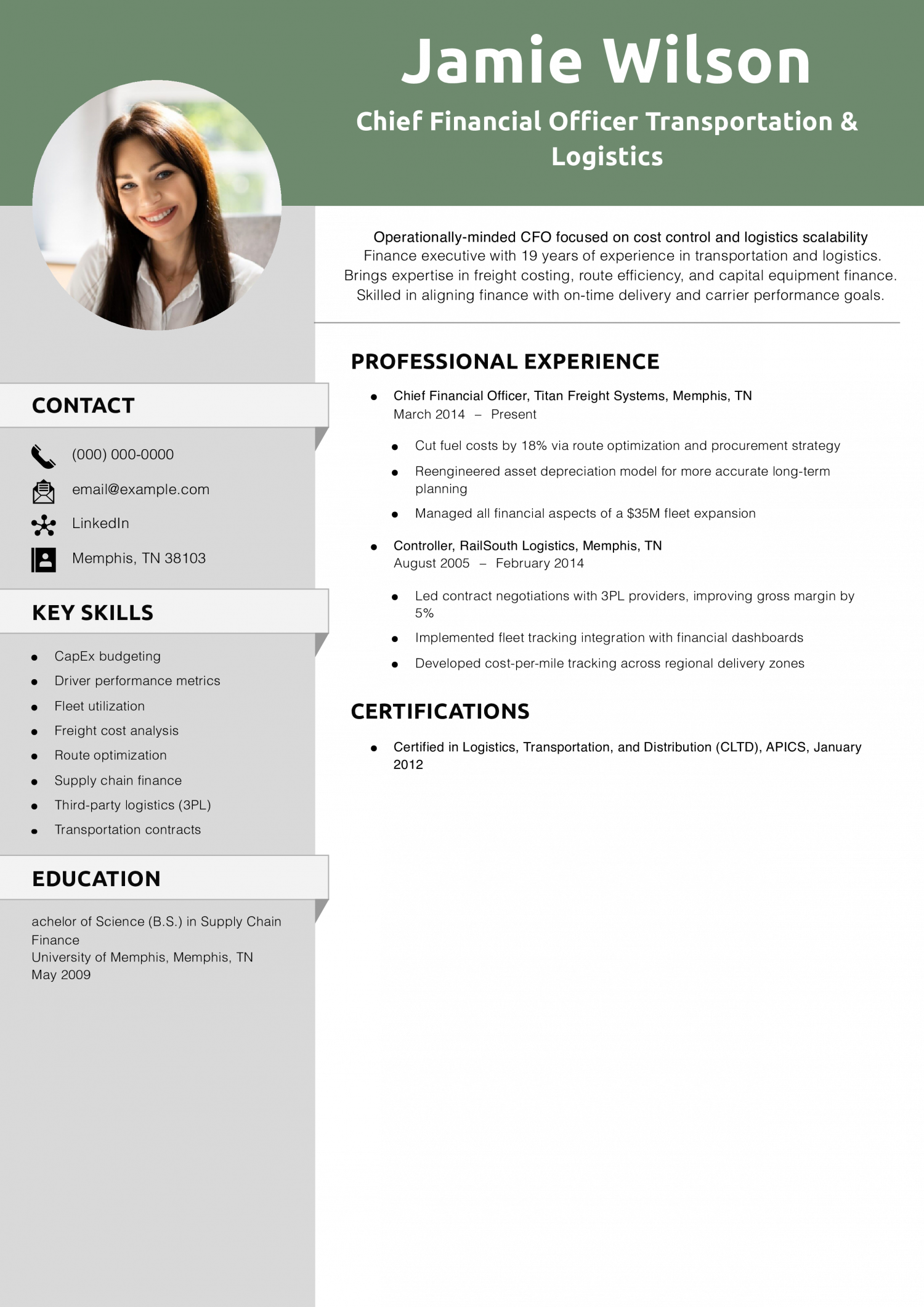
Why this transportation CFO resume example is strong:
Jamie’s resume blends finance and logistics language, showing direct impact on operational costs. The accomplishments show the ability to scale responsibly.
Chief Financial Officer SaaS Resume Example
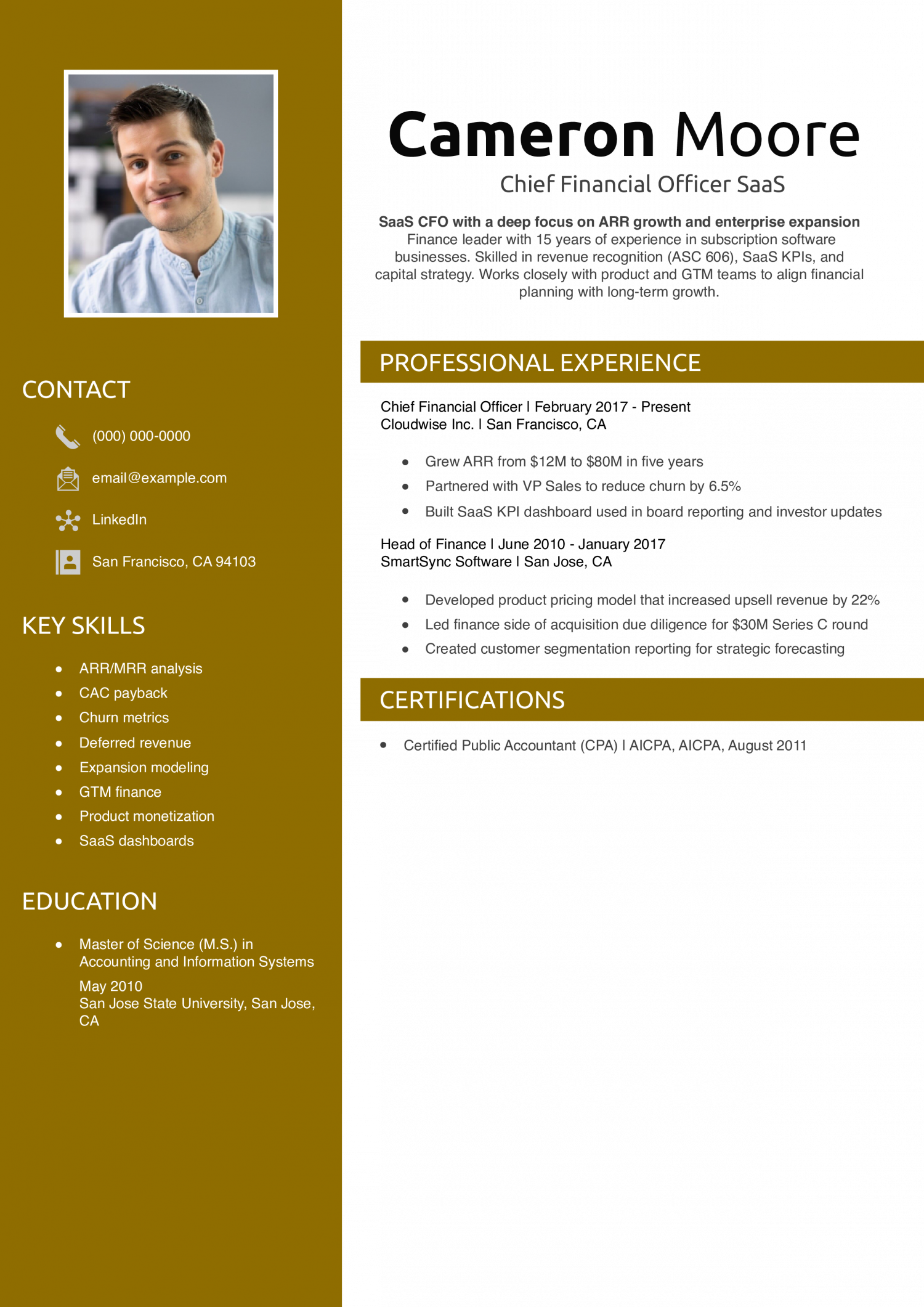
Why this SaaS CFO resume example is strong:
Cameron uses SaaS-specific metrics and acronyms fluently. Investors and boards expect CFOs to monitor churn, expansion, and LTV—this resume delivers on all fronts.
Chief Financial Officer Agribusiness Resume Example
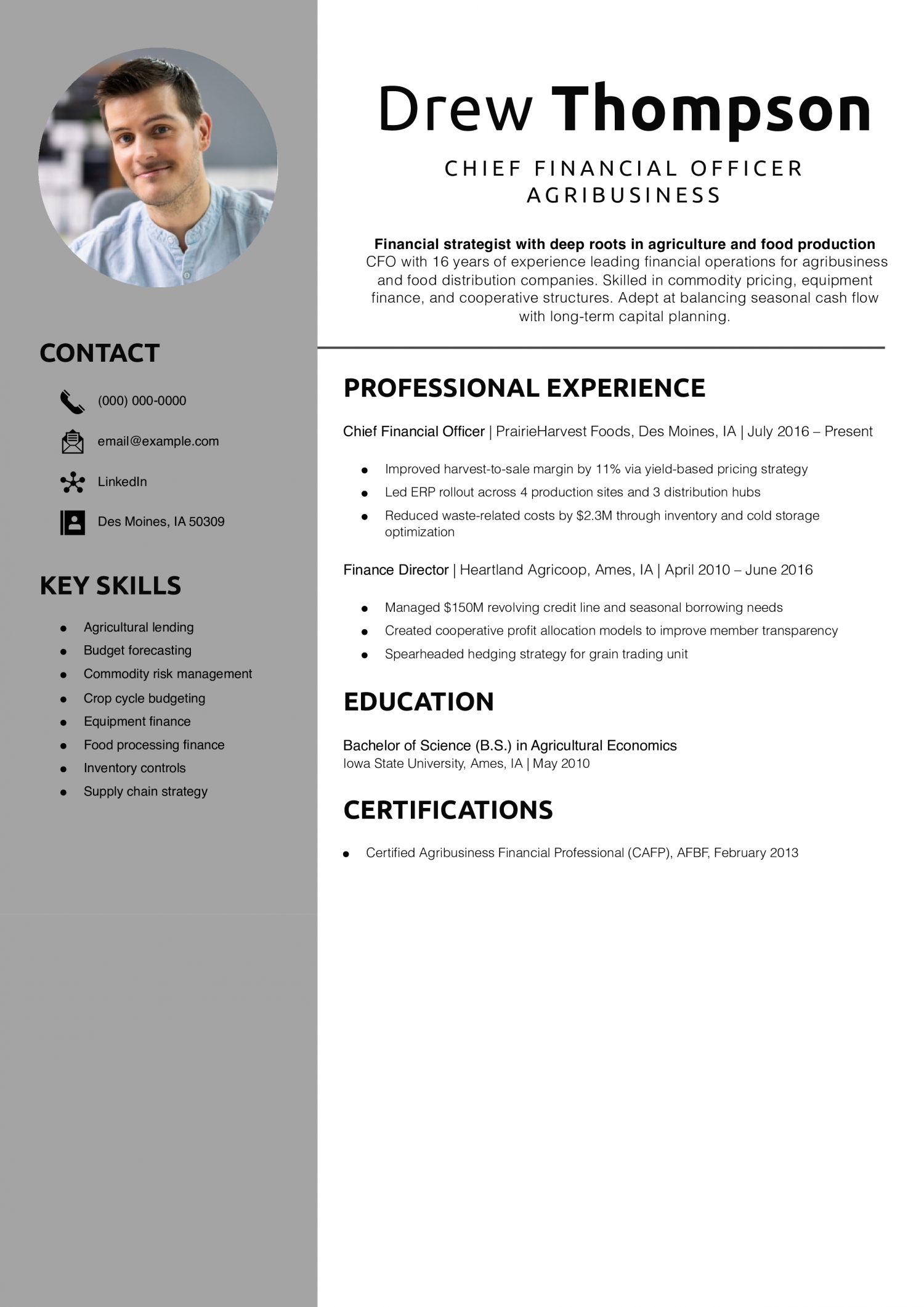
Why this agribusiness CFO resume example is strong:
Drew’s resume is grounded in agriculture-specific finance functions. From seasonal cash flow to cooperative accounting, it speaks directly to industry needs.
Chief Financial Officer Insurance Resume Example
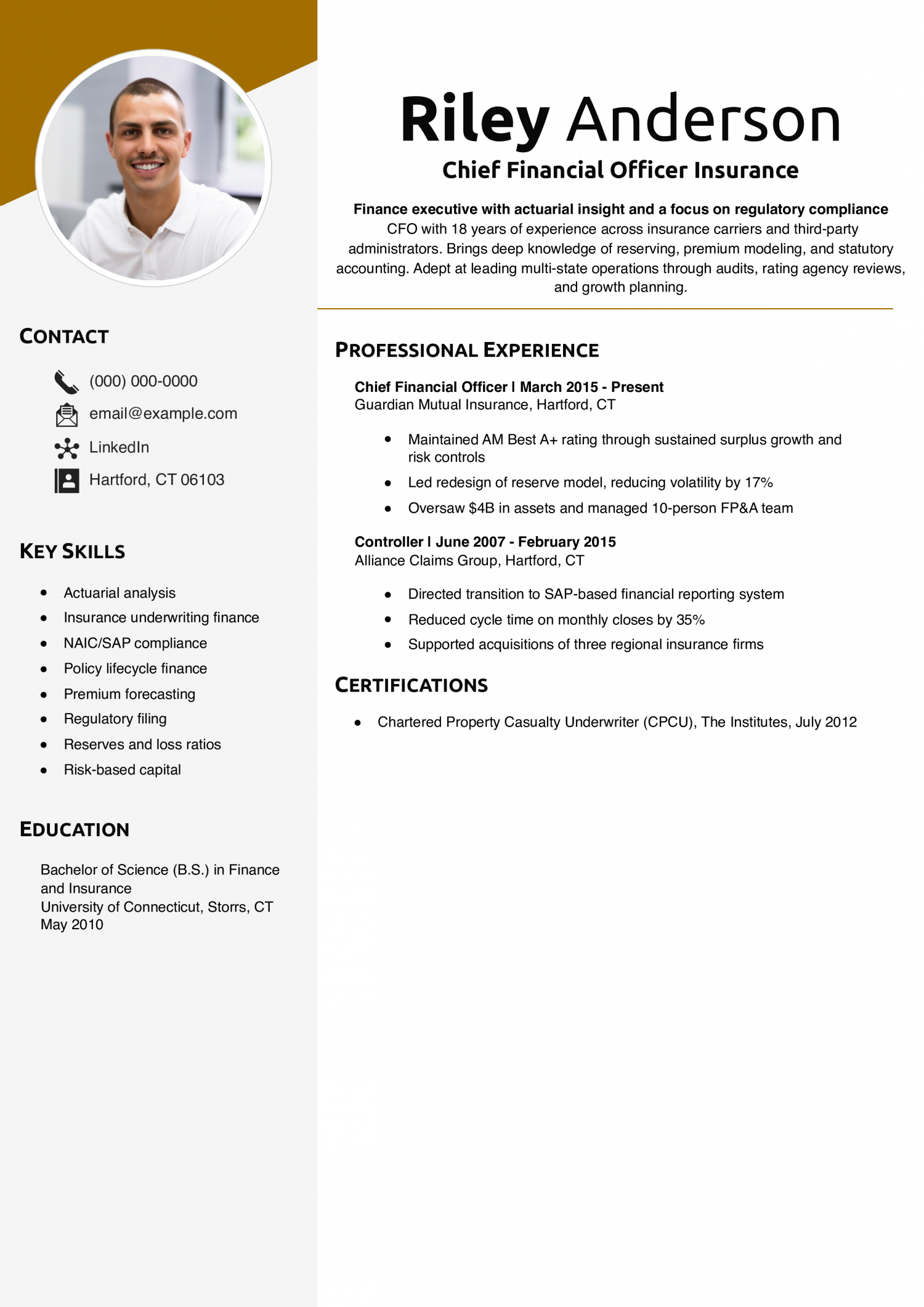
Why this insurance CFO resume example is strong:
Riley includes key industry terms like reserves, SAP, and AM Best. The resume blends financial stewardship with an understanding of underwriting and actuarial impacts.
Chief Financial Officer Media and Entertainment Resume Example
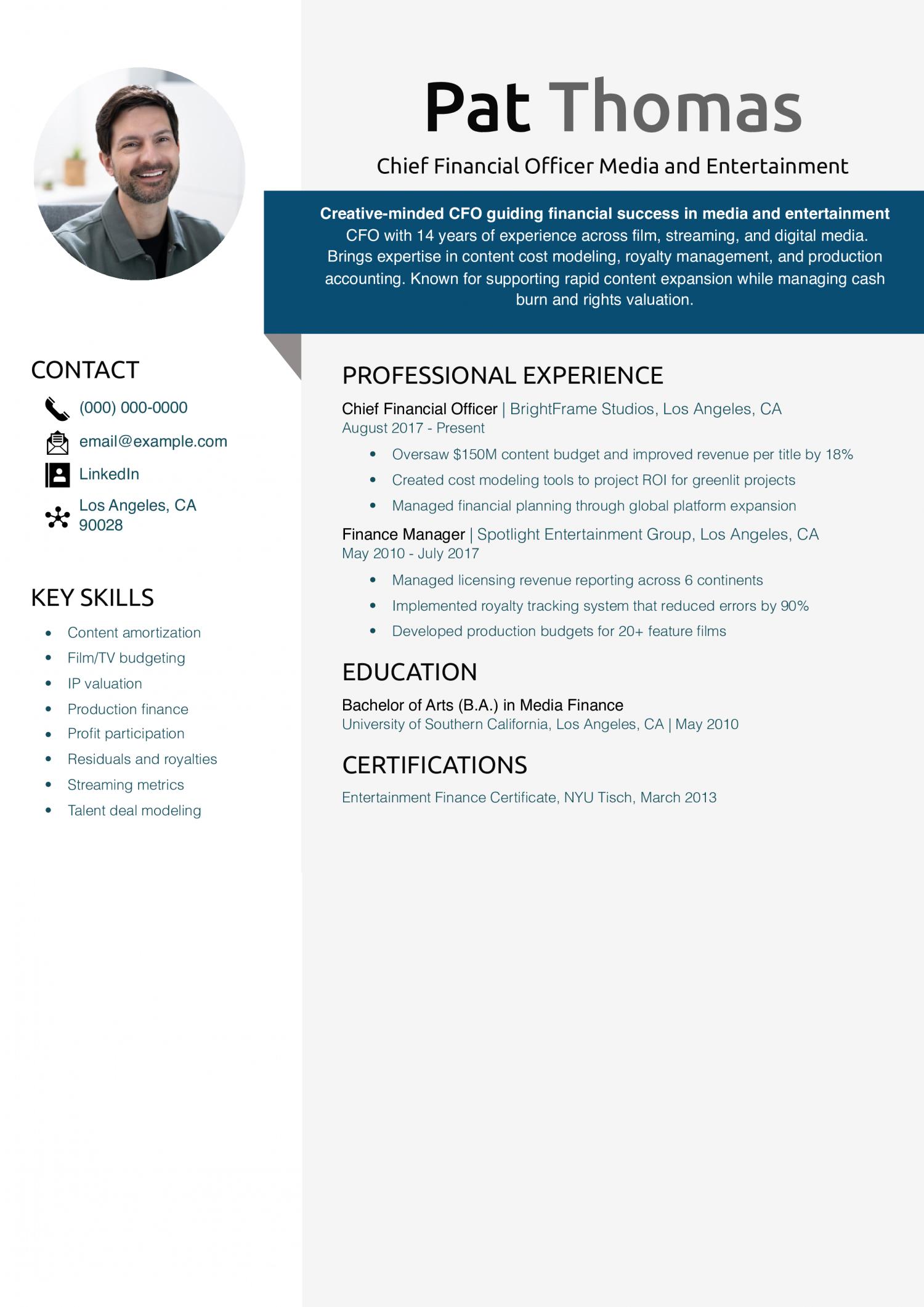
Why this CFO media and entertainment resume example is strong:
Pat’s resume uses media-industry terms and metrics (residuals, licensing, content ROI). It highlights CFO-level support for creative and monetization strategies.
Chief Financial Officer (CFO) Text-Only Resume Examples and Templates
How To Write a Chief Financial Officer (CFO) Resume
A template can help you organize your career information for an effective CFO resume. Your CFO resume should usually have these sections:
- Contact information
- Profile
- Key skills
- Professional experience
- Education and certifications
Before starting work on your resume, jot down any preferences you have for your target job duties, industry, company size, or work culture. These notes will help you determine and emphasize your best career details as you develop each section.
1. Share your contact information
Give your full name, phone number, email address, location, and links to any online professional profiles. When applying to jobs, double-check your contact info for accuracy – it’s as important as anything else on your resume.
Template:
YOUR NAME
(123) 456-7890 | [email protected] | City, ST 09876 | LinkedIn
2. Create a profile by summarizing your CFO qualifications
Impress employers at the top of your resume by giving the three to five main reasons you can excel as their next CFO. Consider what sets you apart from other candidates, such as your:
- Years of related executive experience
- Main strengths or finance specialties
- Advanced degree or certification(s) in your field
(Note: Most job seekers find it easier to write their profile last.)
Example:
Chief financial officer with over 15 years of experience guiding financial strategy for public and private companies across SaaS and fintech. Proven ability to lead IPO preparation, secure multimillion-dollar funding rounds, and grow EBITDA by double digits. Trusted business partner to CEOs and board members.
3. List key skills and proficiencies for CFO
A skills section (typically right under the profile) lets you quickly show the different ways you can contribute in your target position. Below, you’ll find some key terms and skills to consider for this section:
| Key Skills | |
|---|---|
| Budgeting and forecasting | Business needs assessment |
| Capital fundraising | Cash flow management |
| Change leadership | Cost reduction strategy |
| Data-driven decision making | Enterprise resource planning (ERP) systems |
| Financial modeling | GAAP and SEC compliance |
| IPO and exit strategy | Investor relations |
| Mergers and acquisitions (M&A) | Policy development |
| Profit and loss (P&L) oversight | Risk management |
| Sarbanes-Oxley (SOX) compliance | Strategic planning |
| Tax strategy | Treasury management |
| Valuation | |
4. Create detailed descriptions of your relevant experience
For each job in your recent work history, brainstorm your (possibly various) duties and achievements on a separate document or sheet of paper. Then, review your notes in light of your target CFO job, and choose the most relevant ones to feature as bullet points in this section. By filtering your information this way, you can create an experience section that’s both detailed and focused.
Plan on giving just a brief overview of any unrelated jobs (even ones you held a long time), and a detailed account of any highly related jobs (even ones you held only briefly). Far from misleading, this approach gives employers the clearest measure of your background relevant to the role they hope to fill.
Example:
Chief Financial Officer, Keywave Technologies, Austin, TX | June 2017 to present
- Increased gross margins by 12% through strategic cost restructuring and vendor renegotiations across global supply chain
- Led financial due diligence and integration for two acquisitions, contributing to a 34% revenue increase
- Partnered with CEO and board to guide the company through a $120 million Series C funding round
- Built a high-performing finance team of 25 and introduced KPI dashboards for better cross-functional visibility
Resume writer’s tip: Quantify your experience
When possible, cite relevant performance data and metrics to show the results you’ve achieved. Hard numbers put your work in context and give recruiters a better sense of your scope and impact.
If you’re trying to move from a large firm to a startup or vice versa, some of your data may not speak to this goal. But you can still capture the impact and substance of your work by trading out numbers for percentages. For instance, if you have “Grew portfolio by 80 clients,” you can instead say “Grew client portfolio by 30%.”
Do
- "Reduced operating expenses by 18% within one fiscal year, increasing EBITDA by $4.2 million’’
Don’t
- "Responsible for reducing operating expenses"
Resume writer’s tip: Tailor your resume to each application
Before sending your resume, review it carefully against the job posting. Delete any details that don’t speak to the requirements, and consider using that space for more information about your relevant experience. This process takes extra time, obviously. But it can shorten your overall job search by giving you an edge over the many applicants who send a more general, less convincing resume.
What if you have no CFO experience?
As long as the job posting doesn’t strictly require it, you don’t need direct work experience to write an effective resume. The trick is focusing on your transferable skills, which can come from various areas such as your other past jobs, volunteer positions, or professional development. By detailing these areas in full on your resume, you can ensure it helps you get interviews for your target job.
5. Add your education and relevant certifications
With the education and certifications sections, you can show you have a strong knowledge base in your field. Cite any credentials you’ve earned that speak to your abilities as a CFO. Below are templates and examples to help you organize this information on your resume (note, years are optional).
Education
Template:
[Degree Name], [School Name], [City, ST] | [Graduation Year]
[Relevant honors, coursework, or activities]
Example:
Master of Business Administration (MBA) in Finance, University of Michigan | Ann Arbor, MI
Certifications
Template:
[Certification Name], [Awarding Organization] | [Completion Year]
[Description if the credential is lesser-known but relevant]
Example:
Chartered Financial Analyst (CFA) Level III Candidate, CFA Institute
Resume writer’s tip: Use common action verbs
Dynamic verbs help you keep the reader’s attention and tell a compelling story about your experience.
The following list can help you find a good mix of action verbs for your CFO resume:
| Action Verbs | |
|---|---|
| Adapted | Audited |
| Boosted | Built |
| Clarified | Coordinated |
| Created | Decreased |
| Directed | Doubled |
| Drove | Earned |
| Encouraged | Enhanced |
| Forecasted | Fostered |
| Generated | Grew |
| Guided | Improved |
| Increased | Introduced |
| Led | Lowered |
| Managed | Negotiated |
| Oversaw | Prevented |
| Ranked | Reduced |
| Restructured | Reversed |
| Revitalized | Secured |
| Streamlined | Supervised |
| Updated | Won |
How To Pick the Best Chief Financial Officer (CFO) Resume Template
The best resume templates are simple and easy to edit. Choose one that lets you quickly add, delete, flesh out, rearrange, and reorder sections. With a flexible design, you can tailor and optimize your resume for each job application.
Frequently Asked Questions: Chief Financial Officer (CFO) Resume Examples and Advice
First, look closely at the job post text and note any words that are repeated or emphasized. Compare these phrases with the language in your resume, particularly the profile and key skills sections. Then, seek ways to align your resume language with the job posting while not copying phrases or misstating your background.
For example, if the organization seeks someone collaborative, call out that aspect of your experience in your profile. Or say the company has many non-English speaking customers and business partners. Cite your foreign language skills both in your profile and as a separate section farther down the document. With adjustments like these, you can make your resume more relevant to each opportunity.
Most CFOs should use the combination (or hybrid) format. True to its name, this format combines two important features of other resume formats: the chronological format's experience section and the functional format's profile section. (The resume examples on this page all use combination format.)
A combination resume offers the best of both worlds by fusing these two features. The experience section lets you outline your recent work history - essential information for most employers. At the same time, the profile section enables you to display your career highlights at the top, whether they're from that work history or another part of your background. As a result, you can present yourself both clearly and strategically.
Include a cover letter with your resume
A good cover letter sharpens your job application by saying directly why you’re interested in the organization or job opening at hand. When possible, quote or paraphrase text from the job posting and explain why it caught your attention.
Check Out Related Examples
Resume Templates offers free, HR approved resume templates to help you create a professional resume in minutes. Choose from several template options and even pre-populate a resume from your profile.

